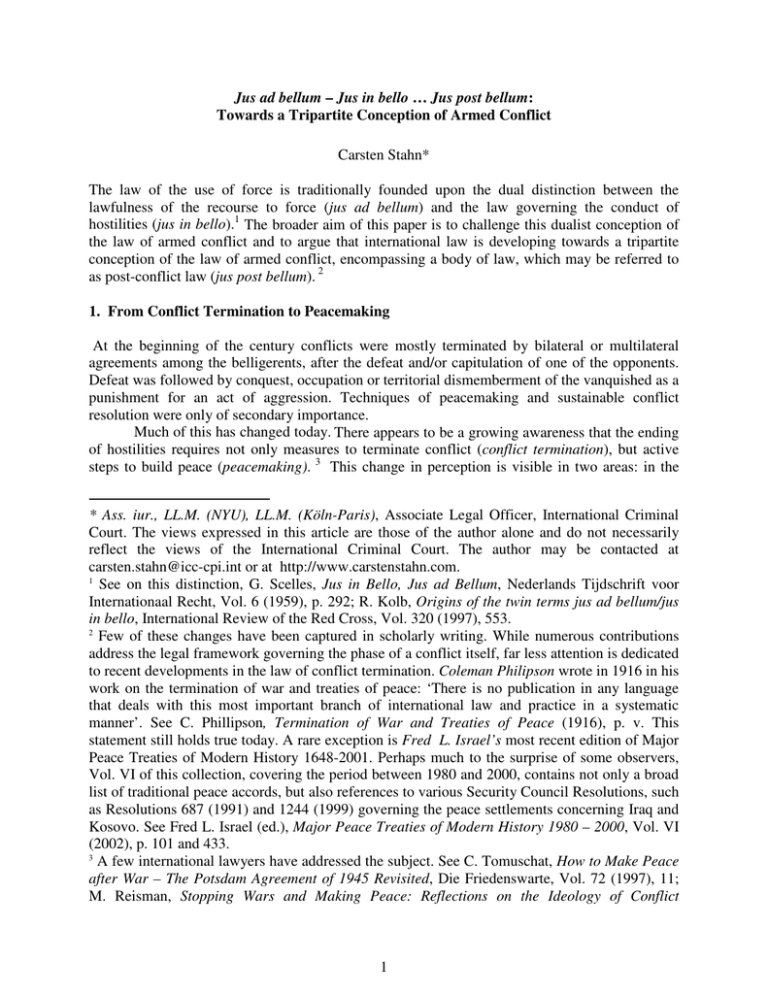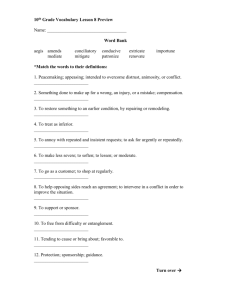Jus in bello … Jus post bellum - European Society of International Law
advertisement

Jus ad bellum – Jus in bello … Jus post bellum: Towards a Tripartite Conception of Armed Conflict Carsten Stahn* The law of the use of force is traditionally founded upon the dual distinction between the lawfulness of the recourse to force (jus ad bellum) and the law governing the conduct of hostilities (jus in bello).1 The broader aim of this paper is to challenge this dualist conception of the law of armed conflict and to argue that international law is developing towards a tripartite conception of the law of armed conflict, encompassing a body of law, which may be referred to as post-conflict law (jus post bellum). 2 1. From Conflict Termination to Peacemaking At the beginning of the century conflicts were mostly terminated by bilateral or multilateral agreements among the belligerents, after the defeat and/or capitulation of one of the opponents. Defeat was followed by conquest, occupation or territorial dismemberment of the vanquished as a punishment for an act of aggression. Techniques of peacemaking and sustainable conflict resolution were only of secondary importance. Much of this has changed today. There appears to be a growing awareness that the ending of hostilities requires not only measures to terminate conflict (conflict termination), but active steps to build peace (peacemaking). 3 This change in perception is visible in two areas: in the * Ass. iur., LL.M. (NYU), LL.M. (Köln-Paris), Associate Legal Officer, International Criminal Court. The views expressed in this article are those of the author alone and do not necessarily reflect the views of the International Criminal Court. The author may be contacted at carsten.stahn@icc-cpi.int or at http://www.carstenstahn.com. 1 See on this distinction, G. Scelles, Jus in Bello, Jus ad Bellum, Nederlands Tijdschrift voor Internationaal Recht, Vol. 6 (1959), p. 292; R. Kolb, Origins of the twin terms jus ad bellum/jus in bello, International Review of the Red Cross, Vol. 320 (1997), 553. 2 Few of these changes have been captured in scholarly writing. While numerous contributions address the legal framework governing the phase of a conflict itself, far less attention is dedicated to recent developments in the law of conflict termination. Coleman Philipson wrote in 1916 in his work on the termination of war and treaties of peace: ‘There is no publication in any language that deals with this most important branch of international law and practice in a systematic manner’. See C. Phillipson, Termination of War and Treaties of Peace (1916), p. v. This statement still holds true today. A rare exception is Fred L. Israel’s most recent edition of Major Peace Treaties of Modern History 1648-2001. Perhaps much to the surprise of some observers, Vol. VI of this collection, covering the period between 1980 and 2000, contains not only a broad list of traditional peace accords, but also references to various Security Council Resolutions, such as Resolutions 687 (1991) and 1244 (1999) governing the peace settlements concerning Iraq and Kosovo. See Fred L. Israel (ed.), Major Peace Treaties of Modern History 1980 – 2000, Vol. VI (2002), p. 101 and 433. 3 A few international lawyers have addressed the subject. See C. Tomuschat, How to Make Peace after War – The Potsdam Agreement of 1945 Revisited, Die Friedenswarte, Vol. 72 (1997), 11; M. Reisman, Stopping Wars and Making Peace: Reflections on the Ideology of Conflict 1 consolidation of the concept of ‘positive peace’ in the peacemaking practice of the United Nations4, and in state practice in the field of peace treaties. The erosion of the concept of negative peace is quite clearly reflected in a number of changes within UN practice: the broad interpretation of the notion of ‘threat to the peace’ under Article 39 of the Charter by the Security Council, linking the issue of security to the protection of human rights and democracy5; the establishment of international or internationalized criminal institution for the restoration of the rule of law in post-conflict territories (Yugoslavia, Rwanda, Sierra Leone, Kosovo, East Timor), the development of peacekeeping from a device of neutralization to a mechanism of promoting social, economic and legal reconstruction in postconflict territories, including the administration of territories 6; and last but not least, the increasing reliance of UN members on values of liberal peace (democratization, humanitarian consideration) to justify or legitimate interventions (Haiti, Kosovo, Iraq).7 Similar indications for the transformation of the concept of peace developments may be derived from state practice in the area of peace treaties. Evidence shows that there has generally been a significant increase of peace agreements in the 1990’s.8 Furthermore, where peace agreements have been concluded, they usually incorporated elements of conflict management (power-sharing arrangements, human rights mechanisms, third party monitoring etc.).9 These developments challenge the diametrical opposition of the states of war and peace in international relations. The concepts of war, or (in the language of today) armed conflict and peace itself have become increasingly intertwined after World War II. At the same time, Termination in Contemporary World Politics, Tulane Journal of International and Comparative Law, Vol. 6 (1998), 5; J. M. Mathews, The Termination of War, Michigan Law Review, Vol. 19 (1920), 819; A. Gerson, War, Conquered Territory, and Military Occupation in the Contemporary International Legal System, Harvard International Law Journal, Vol. 18 (1977), 525. Furthermore, there is a growing volume of conflict-resolution literature. See S. C. Combala (ed.), Strategic War Termination (1986); Paul R. Pillar, Negotiating Peace: War Termination as a Bargaining Process (1983); Stuart Albert & Edward Luck (eds.), On the Endings of Wars (1980); A.J.P. Taylor, How Wars End (1985); Nissan Oren (ed.), Termination of War: Processes, Procedures and Aftermaths (1982). 4 On ‘positive peace’, see Johan Galtung, Three Approaches to Peace: Peacekeeping, Peacemaking and Peacebuilding, in Peace, War and Defence – Essays in Peace Research, Vol. 2, (1975), 282-304 5 See Frowein/Krisch, On Article 39, in Charter of the United Nations (B. Simma, ed.), 2nd. ed. 2002, 720, para. 7. 6 See generally R. Wilde, Representing International Territorial Administration: A Critique of Some Approaches, European Journal of International Law, Vol. 15 (2004), 71. 7 Theories of ex post legitimation have, in particular, been advanced to validate the ECOWAS operations in Liberia and Sierra Leone and Operation Allied Force in Kosovo. See T. M. Franck, Recourse to Force: State Action Against Threats and Armed Attacks (2002), p. 158-162. See also R. Müllerson, Jus Ad Bellum; Plus ça change (le monde), plus c’est la même chose (le droit), Journal of Conflict and Security Law, Vol. 7 (2002), p. 149, at 182. For an analysis of the case of Iraq, see C. Stahn, Enforcement of the Collective Will and the Use of Force Against Iraq, American Journal of International Law, Vol. 97 (2003), 804. 8 See generally W. G. Grewe, Peace Treaties, in Encyclopedia of Public International Law, Vol. III (1997), 938, at 940. 9 See generally Christine Bell, Peace Agreements and Human Rights (2000), 20-32. 2 principles of the traditional ‘law of peace’ are increasingly applied to societies, which are neither in a clear situation of war or peace, but involved in a process of transition from conflict to peace. 2. Inadequacies of a Dualist Conception of the Law of Armed Force The structural changes in the conception of peacemaking are not adequately captured in the contemporary conceptualization of the law of armed force. The restoration of peace and justice in post-conflict situations has, in fact, in many ways become the other side of intervention. The structural framework of international law, however, with its classical division in the concepts of jus ad bellum and jus in bello has not been adapted to these changes. This distinction stems from a time when peace settlements were conceived as mutual bargaining processes among states over post-war rights and obligations and when international law was more or less neutral towards the process of post-conflict reconstruction and statebuilding.10 Both strands of law contain therefore only a nucleus of principles addressing the post-conflict period. Concepts such as individual criminal responsibility or the ‘humanization’ of the conduct of warfare11 and its implications through human-rights based limitations were far less developed at the time, when the current rules of jus ad bellum and jus in bello were originally conceived. Furthermore, the law of occupation, the only body of law which deals explicitly with post-conflict relations, has largely fallen in abeyance in the second half of the 20th century.12 3. Traces of a Tripartite Conception of Armed Conflict Both, the empirical evidence of the consolidation of the concept of positive peace in international practice, and the shortcomings of the existing branches of the law of armed conflict to address the increasing link between conflict termination and peacemaking invite some thinking as to whether the prevailing dualist division of the law of armed force into the two exclusive categories of jus ad bellum and jus in bello is lacunary in the sense that it must be complemented by a third category of law: the law governing the restoration of peace after conflict (jus post bellum).13 The plea for a tripartite conception of rules of armed conflict has some precedents in international legal history. Francisco Suarez, for example, argued in favour of extending the just Enriques used the term jus ad bellum in 1928. See G. Enriques, Considerazioni sulla teoria della guerra nel diritto internazionale, Rivista di diritto internazionale, Vol. 20 (1928), p. 172. Later, Kunz took up the notion in an article published in 1934. See J. Kunz, Plus de lois de guerre ?, Revue générale de droit international public, Vol. 41 (1934), 22. However, the breakthrough came only after the end of the Second World War, when the express distinction between jus ad bellum and jus in bello gained widespread acceptance in monographs. See, for example, L. Kotzsch, The Concept of War in Contemporary History and International Law (1956), 86 and 89. 11 See T. Meron, The Humanization of Humanitarian Law, American Journal of International Law, Vol. 94 (2000), 239. For a human rights-based interpretation of the laws of war, see e.g. Francisco Forrest Martin, Using International Human Rights Law for Establishing a Unified Use of Force Rule in the Law of Armed Conflict, Saskatchewan Law Review, Vol. 64 (2001), 347 12 See generally E. Benvenisti, The International Law of Occupation (1993). 13 For discussion of this concept, see also B. Orend, Terminating Wars and Establishing Global Governance, Canadian Journal of Law & Jurisprudence, Vol. 12 (1999), 253; id. Justice After War, Ethics & International Affairs, Vol. 16 (2002), 43. 10 3 war categories to a third period, namely the ending of justly declared and fought wars.14 Grotius and Vattel formulated some general principles concerning the form and technicalities of conflict termination.15 Furthermore, Kant expressly divided the ‘right of nations in relation to the state of war’ into three different categories, namely ‘1. the right of going to war; 2. right during war; and 3. right after war, the object of which is to constrain the nations mutually to pass from this state of war and to found a common constitution restablishing perpetual peace’ (Science of Rights, 1790).16 Unfortunately, few attempts have been undertaken to systematize these ideas or to fill the notion of post-conflict law with concrete legal content. This is the point where this research comes in. It seeks to take the debate a step further, by identifying several substantive principles of post-conflict law, which shape the very contents and strategies of peacemaking. 4. Methodology On a methodological level, the most reasonable approach to assess the changes within the international legal system is to look at the law and state practice in times of profound transformation. It is therefore worth undertaking a comparative analysis of peacemaking in the three major eras of peace settlements in the 20th century, namely 1919, 1945 and the 1990’s, in order to highlight the major shifts in legal practice. 5. Communitarization and Legalization: Changes on the Macro-level This survey shows that the difference between peacemaking in 1919 or 1945 and today is not only one in quantity, but one in substance. Modern practice displays a stark tendency to move from a statist and national-interest driven conception of conflict termination to a pluralist and problem-solving approach to peacemaking uniting affected parties, neutral actors and private stakeholders in their efforts to restore sustainable peace.17 A. Versailles The peace model of Versailles contained significant traces of modernity, such as the early reference to right of self-determination, the provision for the punishment of war criminals and the See F. Suarez, The Three Theological Virtues, Disputation XIII, in: Selections From Three Works (G.L. Williams, A Brown, and J. Waldon, in Classics of International Law, Vol. 20 (James Brown Scott ed.), 1995 p. 836. 15 See H. Grotius, De Jure Belli ac Pacis, Book Three, in Classics of International Law (James Brown Scott, ed., 1995). Vol. 2, Translation by Francis W. Kelsey. See also E. de Vattel, Le Droit des Gens, ou Principes de la Loi Naturelle, appliqués à la Conduite et aux Affaires des Nations et des Souverains, Vol. III (1758), English translation, The Law of Nations or the Principles of Natural Law Applied to the Conduct and to the Affairs of Nations and of Sovereigns, in James Brown Scott (ed.), The Classics of International Law, Vattel, Text of 1758, Books I-IV (1995), at 15. 16 See I. Kant, The Science of Right (1790), under 58 (Right after War). 17 For an excellent survey, see Benedict Kingsbury, The International Legal Order, in Oxford Handbook of Legal Studies (Peter Cane & Mark Pushnet, eds. 2003), 271- 297. 14 4 integration of the founding instrument of the League of Nations into the peace settlement.18 Moreover, by bringing together more than fifty technical expert commissions to discuss territorial, economic, ethnographic and strategic issues over a periods of six months, the Peace Conference got further away from mere dictatorial methods of control and nearer to the methods of scientific and dispassionate inquiry … than any former conference.19 However, like at past peace conferences, power politics and strategic considerations played a significant role. Selfdetermination was not conceived as a binding mandate, but as a guiding principle. Where it conflicted with overriding strategic interests, it had to give way. Moreover, the terms of the peace were essentially set by a bargaining process of the victors over the rights and obligations of the vanquished. B. Settlements after World War II The peace settlements after World War II present, to some extent, a more nuanced picture. The establishment of the UN Trusteeship System ensured a more systematic application of the right to self-determination to the colonial territories of the defeated states. Reparations were generally limited to a reasonable amount, allowing younger generations to start their lives free from the financial burdens of war. Human rights protection and criminal adjudication became fundamental components of peacemaking. Furthermore, in the cases of Germany and Japan, occupation was conceived as a tool to further the economic and social reconstruction of a whole nation. But peacemaking as whole, continued to be shaped by unilateralism and Machtpolitik. Germany and Japan were not administered under the neutral supervision of the United Nations, but under the authority-based framework of the laws of occupation. The Charter rules were declared inapplicable to the process of peacemaking with the ‘enemy’ powers.20 Furthermore, the Allied Powers continued to defend the conviction that forcible acquisitions of territory are an appropriate recompense for wartime losses. C. Contemporary Practice The evolution of international law in the post-war era and the peacemaking practice of the 1990’s have modified this picture. Changing conceptions of state sovereignty and-non-intervention, the rise of liberal democracy, and a new focus on ‘internal self-determination’ and democratic entitlement have increasingly pushed international actors to shape the face of peacemaking through norm- and value-based principles. Furthermore, the end of the Cold War has given new life to multilateralism, favouring collective and globalized approaches to peacemaking. Two major developments deserve to be mentioned, in particular. First, peacemaking has moved beyond the borders of inter-state bargaining within the confines of self-interested or For a discussion, see E. von Puttkammer, Versailles Peace Treaty, in Encyclopedia of Public International Law, Vol. IV (2000), 1277. 19 See T. M. Franck, The Power of Legitimacy Among Nations (1990), 154-155. 20 This is clearly reflected in the ‘enemy state’ clause contained in Art. 107 of the UN Charter, which states that ‘[n]othing in the present Charter shall invalidate or preclude action, in relation to any state which during the Second World War has been an enemy of any signatory to the present Charter, taken or authorized as a result of that war by the Governments having responsibility for such action’ 18 5 bilateral dispute settlement. It has become part of a normative framework, that furthers and posits micro- or macro-community interests. Secondly, one may observe that the process of peacemaking itself has become subject to legalization and regulation. There is a clear tendency to recognize that realist and balance of power based models of political discourse alone are insufficient to achieve sustainable peacemaking. This perception is reflected in the emergence of a set of substantive legal rules and principles of procedural fairness governing processes of post-conflict peacemaking that complement traditional strategies of political realism (Great Power balances, deterrence, diplomacy, etc.). 4. Organizational Principles of Post-conflict Peace Based on the assessment of international practice and existing treaty law, there is authority to argue there are, at least, seven organizing principles which may be said to form part of an emerging body of post-conflict law: (1) the requirement of procedural fairness in the formation of peace settlements, (2) the demise of the concept of territorial punishment for acts of aggression, (3) the humanization of post-conflict reparations, (4) the exclusion of amnesties for serious crimes in peace settlements, (5) the need to institutionalize individual and group rights in postconflict peace processes, (6) the move from collective responsibility to individual responsibility and (7) the necessity to internationalize peacemaking to legitimate governance and intervention. A. Procedural Fairness in the Formation of Peace Settlements The first principle that may be deduced from the historical evolution of peacemaking is that the establishment of sustainable peace requires a collective bargaining process, involving a fair hearing of the interests of all parties to the conflict at the negotiating table. This point is not expressly reflected in the Vienna Convention. But it receives strong support from the peacemaking practice of the 1990’s which has established the principle of the neutralization of the bargaining process as one of the central parameters of sustainable peacemaking. The cases of SC Resolution 687 on Iraq and SC Resolution 1244 on Kosovo indicate a departure from the misguided perception that an aggressor has no right to a fair treatment in the settlement of post-conflict peace.21 Furthermore, agreements like the Dayton Accord or the Ethopia-Eritrea agreement send the unequivocal message that a state using force against another entity should be present when the terms of peace are negotiated. B. The Demise of the Concept of Punishment for Aggression Secondly, international practice since 1945 indicates the replacement of the harsh concept of territorial punishment for purposes of deterrence by the more moderate techniques of state stateresponsibility, disarmament and institutional security arrangements. For a discussion SC Resolution 687 as a surrogate peace treaty, see B. Fassbender, Uncertain Steps into a Post-Cold War World: The Role and Functioning of the UN Security Council after a Decade of Measures against Iraq, European Journal of International Law, Vol. 13 (2002), 273, at 279. 21 6 International law has become hostile to the idea of ‘punishing’ an aggressor through the imposition or dictate of territorial changes in the post-conflict phase.22 Territorial mutilations or compulsory transfers of populations of the kind that took place at the end of the Second World War would be ruled out today under the UN Charter and the 1949 Geneva Conventions. The Draft Articles of the International Law Commission on State Responsibility refrain from approving any concept of punishment of a state for the commission of unlawful acts of force.23 The only organ, which could theoretically take punitive measures against states that have placed themselves outside the community of peace-loving and law-abiding nations, is the Security Council. However, even the Council’s authority is limited in this regard. The mere objective of deterring future aggression would hardly suffice to justify permanent transfers of territory against or without the will of a state, because other, less intrusive post-conflict measures such as reparation, disarmament and adjudication of war crimes are usually at hand and better suited to serve the purpose of peacemaking. C. The Humanization of Reparations A similar trend for moderation may be traced in the area of reparations. Contemporary developments in international law point to the emergence of a rule that prohibits the indiscriminate punishment of a people through excessive reparation claims.24 Excessive financial loads may not only make a people accountable for misdeeds of an irresponsible regime, but amount to the collective punishment of an entire population. The lesson emerging from practice of peace treaties and the Iraqi case is clearly that reparation and compensation claims must be assessed on the basis economic potential of the wrongdoing state. This conclusion was drawn by the former Article 43 (3) of the 1996 Draft Articles on State Responsibility, which stated that reparation shall ‘in no case … result in depriving the population of a State of its own means of substance’. Furthermore, it receives additional support from the rise of socio-economic human rights obligations, preventing states or international actors from imposing economic liabilities on another state that disable the later to ensure minimum socio-economic standards (food, health care) vis-à-vis its own population.25 D. Towards a Combined Justice and Reconciliation Model A fourth area, which displays a trend towards the accommodation of post-conflict responsibility with the needs of lasting peace is criminal responsibility. See generally S. Korman, The Right of Conquest (1996). As the United Kingdom and Northern Ireland put it in their comments on the 2000 Draft Articles: ‘Generally speaking it is not for an individual State or a group of States, or a tribunal, to punish a State as such. State responsibility is concerned with the redress of wrongs, not the punishment of misdeeds’. Thus, the 2001 Draft Articles limit the consequences of internationally wrongful acts to the level of ‘civil responsibility’, according to which a state can only obtain restitution, compensation and satisfaction for the harm suffered. 24 See I. Brownlie, International Law and the Use of Force by States (1963), at 153. 25 See also the comment of the United Kingdom on former Article 43 (3) of the ILC Draft Articles on State Responsibility, noting reparation must not endanger international peace and security. See UN Doc. A/CN.4/488.104. 22 23 7 This specific tension did not receive broad attention in historical peace settlements, partly because the concept of international criminal responsibility was less developed, and partly because peace settlements were less frequently dedicated to the resolution of the problems of civil wars. However, it is at the heart of contemporary efforts of peacemaking. Modern international practice, in particular in the context of United Nations peacebuilding, appears to move towards an approach which allows limited amnesties for less serious crimes and combines accountability with the parallel establishment truth and reconciliation mechanisms.26 E. From Collectivism to Individualization: The Disaggreation of the State Another remarkable shift in the evolution of conflict termination is the move from a statist conception of peacemaking to individual – and/or group-based responses. One may argue that there is a shift of focus from state-centred mechanisms of organizing public power to ‘people’-based techniques of political settlement. Peacemaking is more than ever before bound to the ending of autocratic, undemocratic and oppressive regimes, and directed towards the ideal of ‘popular sovereignty’ held by individuals instead of states or elites of a state. A procedural legal basis for this claim may be found in Article 21 of the Universal Declaration of Human Rights and Article 25 of the International Covenant on Civil and Political Rights. Moreover, a broader notion of internal self-determination has emerged after World War II, which links the protection of a people under international law to the enjoyment of institutional rights (such as autonomy of federalist structures) in the domestic legal system. Finally, human rights guarantees and procedures for holding governments accountable are increasingly part of a treatybased or ‘regional acquis’, and therefore binding on successor states or regimes.27 F. The Move from Collective Responsibility to Individual Responsibility Similarly, there is a move from collective to individual responsibility. The most important development in this regard is the crystallization of the principle of individual criminal responsibility. It incorporates several ideas. It prohibits collective punishment, that is, punishment of persons not for what they have done, but for the acts of others28; and it establishes See Carsten Stahn, Unites Nations peace-building, amnesties and alternative forms of justice: A change in practice ?, International Review of the Red Cross, Vol. 84 (2002), 191. 27 See, e.g. Human Rights Committee, General Comment No. 26, which established the principle of automatic succession into human rights treaties (‘The rights enshrined in the Covenant belong to the people living in the territory of the State party. The Human Rights Committee has consistently taken the view, as evidenced by its long-standing practice, that once the people are accorded the protection of the rights under the Covenant, such protection devolves with territory and continues to belong to them, notwithstanding change in government of the State party, including dismemberment in more than one State or State succession or any subsequent action of the State party designed to divest them of the rights guaranteed by the Covenant’). 28 This principle is expressed in Article 50 of the Annex to the 1907 Hague Convention No. IV which states that ‘[n]o general penalty, pecuniary or otherwise, shall be inflicted upon the population on account of acts of individuals for which they cannot be regarded as jointly and severally responsible.’ Furthermore, it is no longer possible to inflict penalties on persons who have themselves not committed the acts complained is also contained in Article 33 of the Fourth 26 8 the general rule that individuals are punished for their own wrongdoing, and not on behalf of the state.29 This mechanism helps to prevent that a people is held accountable for the misdeeds of its rulers and exposed to charges of collective guilt The last principle, which deserves closer attention in the context of the evolution of modern peacemaking from Versailles to today, is the principle of internationalization. Internationalization is not a formal requirement of post-conflict peacemaking, but it is an important element of post-conflict peace, in so far as it increases the legitimacy of foreign intervention.30 It is relevant in, at least, two respects. It serves as a legitimating factor for the exercise of governmental authority in post-conflict situations, and it helps to ensure a more democratic sharing of the burdens of reconstruction. Both the rise of self-determination and the increasing need to legitimate decision-making authority in governance relations make it much more difficult to justify the establishment of noninternational governance structures instead of internationalized governing mechanisms in the aftermath of interventions. The direct assumption of authority by the victorious states, which was practiced after World War II and recently again in the case of Iraq, is exposed to criticism because it emancipates notions of neo-imperialism and domination of one state over another. International administering institutions enjoy greater legitimacy than occupying powers in a double sense. For one, they bring an element of impartiality into the post-conflict peace process that can usually not be guaranteed by either of the former parties to the conflict. Secondly, they are mostly vested with a greater degree of expertise in the broad range of reconstruction activities, such as disarmament of previously warring parties, restoration of order, repatriation of refugees, election monitoring, human rights protection and the promotion of economic and political reconstruction. All these factors make the case for the internationalization of peacemaking more compelling than ever before in history. Immanuel Kant stressed the necessity for a framework of principles of post-conflict law over two centuries ago. One may argue that this vision has become a reality today, namely through the emergence of a number of organizing principles for post-conflict peace, which remove peacemaking from its historical realist context and place it within a positivist tradition of positing communitarian interests through a normative conception of law and justice. Geneva Civilian Convention which notes that ‘[c]ollective penalties and likewise all measures of intimidation...are prohibited’. 29 The autonomy of individual responsibility from state responsibility is, in particular, expressed in the removal of official immunity from punishment for aggression, genocide, crimes against humanity and war crimes. See Article 27 of the Rome Statute, Article 7 (2) of the ICTY Statute and Article 6 of the ICTR Statute. 30 The issue of post-intervention obligations has recently been raised by the International Commission on Intervention and State Sovereignty. The Commission noted in its report on the ‘Responsibility to Protect’: ‘The responsibility to protect implies the responsibility not just to prevent and react, but to follow through and rebuild. This means if military intervention action is taken – because of a breakdown or abdication of a state’s own capacity and authority in discharging its ‘responsibility to protect’ – there should be a genuine commitment to helping to build a durable peace, and promoting good governance and sustainable development. Conditions of public safety and order have to be reconstituted by international agents acting in partnership with local authorities, with the goal of progressively transferring to them authority and responsibility to rebuild’. See Report of the International Commission on Intervention and State Sovereignty, The Responsibility to Protect (2001), at 39. 9





